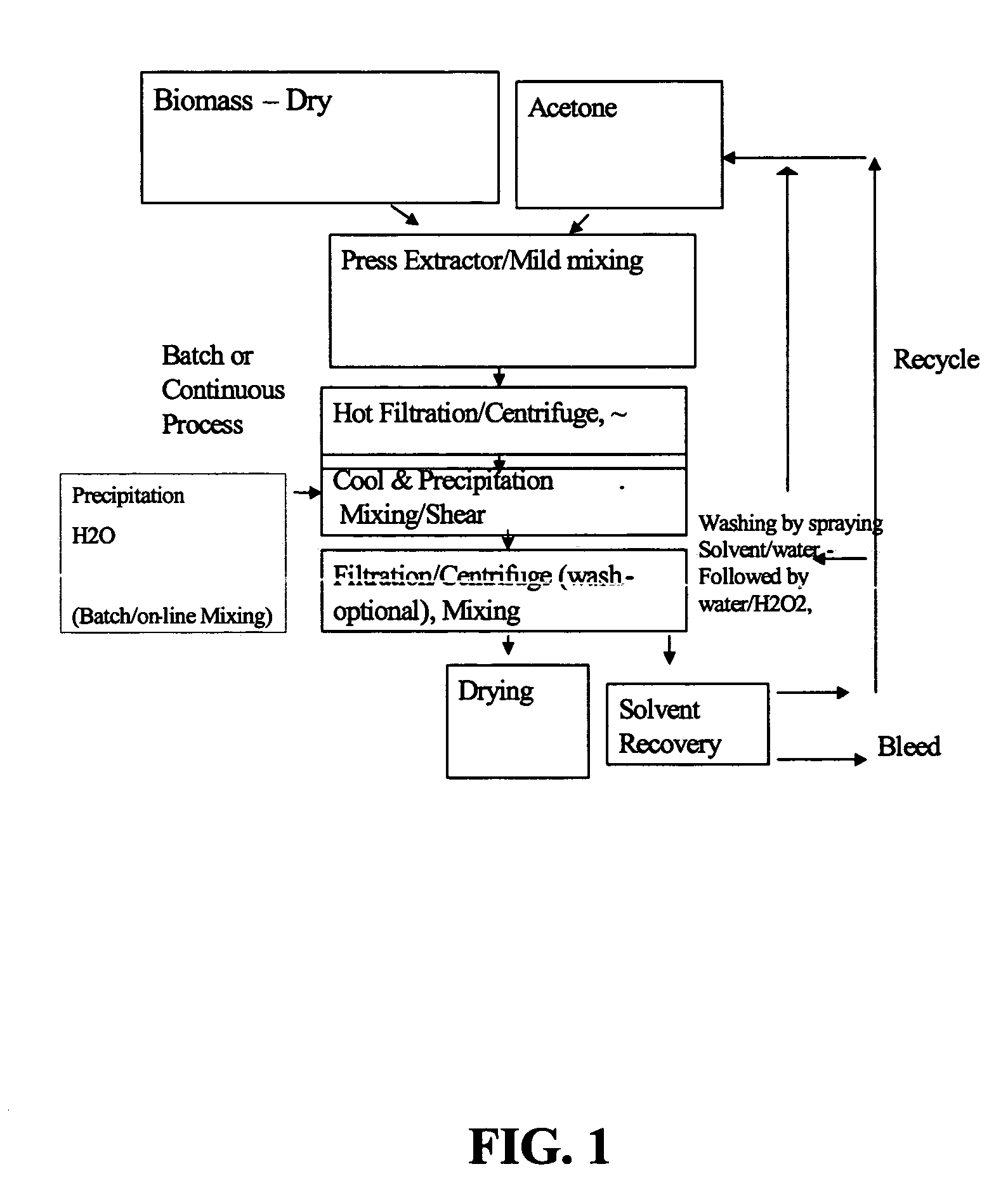Process for the solvent-based extraction of polyhydroxyalkanoates from biomass
a technology of biomass and polyhydroxyalkanoates, which is applied in the direction of solvent extraction, separation processes, microorganisms, etc., can solve the problems of phas degradation both aerobically and anaerobically, petrochemical-based polymers take centuries to degrade after disposal, and synthetic biodegradable polymers, also commonly referred to as “bioplastics,” have not enjoyed great success in the marketplace, etc., to achieve improved quality, a higher degree of a a technology of polyhydroxyalkanoates and biomass extraction and biomass technology, applied in the field of polyhydroxyalkanoate extraction and biomass technology, applied in the field of polyhydroxyalkano biomass technology, applied in the field of polyhydroxyalkanoate and biomass technology, applied in the field of polyhydroxyalkanoate technology, applied in the field of biomass technology, which is applied in the field of biomass extraction, and can solve the a technology of polyhydroxyalkanoates biomass technology, applied in the field of polyhydroxyalkanoate extraction and biomass technology, applied in the field of polyhydroxyalkanoa
- Summary
- Abstract
- Description
- Claims
- Application Information
AI Technical Summary
Benefits of technology
Problems solved by technology
Method used
Image
Examples
example 1
Acetone-Water Process
[0107] To 100 Kg of dried biomass containing approximately 60% PHA (Polyhydroxy Butyrate and Hexanoate copolymer with about 9 mole % of Hexanoate), is added approximately 900 kg of acetone (recycle, wash or fresh acetone with water content of 3%) with moderate mixing to form a slurry. The mixture of biomass and acetone slurry is then heated to about 90° C. and held for about 1 hour to allow separation of PHA from the biomass to occur. This solution, held at the about 90° C. temperature and pressure of approximately 3 Bar is then transferred to the filter (Nutsche filter) or centrifuge under pressure. The spent biomass (solid) is separated from the solution containing PHA and acetone. The solution containing PHA and acetone is then transferred to a precipitation tank and simultaneously water is added at half the rate of the PHA-Acetone solution. Approximately 450 kg of water is used as a precipitating solvent. During precipitation, moderate mixing with P / V of 2 ...
example 2
Acetone-Water Process
[0108] About 13.05 grams of biomass containing about 60% PHA (Polyhydroxy Butyrate and Hexanoate copolymer 6.5 mole % Hexanoate) is mixed with 100 grams of acetone. The mixture is added to a lab set containing a reaction chamber with a sintered metal filter capable of handling moderate temperature and pressure. The reactor is then heated to 90° C. for one hour. The reactor is cooled to about 60° C. and the PHA is filter extracted through a 10 micron filter at the bottom of the reactor. The PHA is precipitated from the filtrate by adding to a heel of acetone-water mixture. Additional water is then added at a ratio of 0.5 parts of water for each 1.0 part of filtrate. The water and acetone are filtered from the precipitated PHA using a Buchner funnel with #40 Whatman filter paper. The filtered PHA is rinsed with acetone. The filtered PHA is spread out in a watch glass and allowed to air dry overnight. A PHA yield of about 80 to 85% is observed.
example 3
Acetone-Water Process with H2O2 Treatment During Drying Process
[0109] About 13.05 grams of biomass containing about 60% PHA (Polyhydroxy Butyrate and Hexanoate copolymer 6.5 mole % Hexanoate) is mixed with 100 grams of acetone. The mixture is added to a lab set containing a reaction chamber with a sintered metal filter capable of handling moderate temperature and pressure. The reactor is then heated to 90° C. for one hour. The reactor is cooled to about 60° C. and the PHA is filter extracted through a 10 micron filter at the bottom of the reactor. The PHA is precipitated from the filtrate by adding to a heel of acetone-water mixture. Additional water is then added at a ratio of 0.5 parts of water for each 1.0 part of filtrate. The water and acetone are filtered from the precipitated PHA using a Buchner funnel with #40 Whatman filter paper. The filtered PHA is rinsed with acetone and then with water. The wet cake is dried in a closed container with some H2O2 solution added at the en...
PUM
| Property | Measurement | Unit |
|---|---|---|
| temperature | aaaaa | aaaaa |
| temperature | aaaaa | aaaaa |
| Power/Volume ratio | aaaaa | aaaaa |
Abstract
Description
Claims
Application Information
 Login to View More
Login to View More - R&D
- Intellectual Property
- Life Sciences
- Materials
- Tech Scout
- Unparalleled Data Quality
- Higher Quality Content
- 60% Fewer Hallucinations
Browse by: Latest US Patents, China's latest patents, Technical Efficacy Thesaurus, Application Domain, Technology Topic, Popular Technical Reports.
© 2025 PatSnap. All rights reserved.Legal|Privacy policy|Modern Slavery Act Transparency Statement|Sitemap|About US| Contact US: help@patsnap.com



